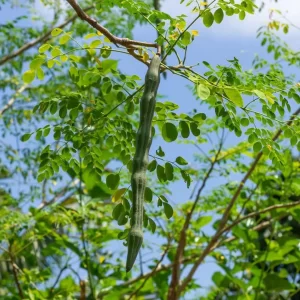Moringa oleifera is a tropical plant featured on this site numerous times for it’s nutrition content and hearty growth. It also happens to be my favorite perennial vegetable.
Nutrition aside, most are unaware Moringa seeds are one of the most effective bio-coagulants for water treatment, especially in turbid surface and river water. Studies have been conducted since the early 1970’s to test the effectiveness of Moringa seeds for treating water. Numerous have shown it to be effective converting turbid water to drinkable standards, meanwhile removing bacteria, toxins and heavy metals. This is a win for third world countries where firewood for boiling is expensive and clean water is scarce. Moringa serves as a cheap but effective water purification option.
In the video below you can see the the flocculation and sedimentation of impurities. This is an example of simple, domestic and nearly free water treatment.
How Do Moringa Seeds Purify Water?
Moringa oleifera seeds treat water in 2 ways. They act as a coagulant and an antimicrobial
agent. Research shows that crushed Moringa seeds work as a coagulant in water due to positively charged,water-soluble proteins. These heavy hitters are known as “moringa oleifera cationic proteins” (MOCP’s). They bind with negatively charged particles (silt, clay, bacteria, toxins,etc) allowing the resulting sedimentation to drop to the bottom. This also reduces bacterial load by over 90%. One study demonstrated Moringa seed extract’s effectiveness at drastically lowering turbidity and even removing Cryptosporidium parvum oocysts in low quality water. (Keep in mind that chlorine doesn’t even kill Crypto)



Moringa’s Antimicrobal Qualities
The bulk of Moringa’s power is the ability to coagulate particulates, bacteria, and toxin, but that’s not all it can do. It also has antimicrobial properties that can make bacteria unable to replicate. This is the equivalent of killing it as the danger of a bacteria’s short life cycle is in it’s ability to reproduce.
The antimicrobial aspects of Moringa continue to be researched. In one study, Moringa oleifera seed powder was shown to effectively drop coliform count in water. In addition, seed extract showed antibacterial activity to the four tested organisms, i.e., Escherichia coli, E. coli, Salmonella typhii and Shigella dysenteriae. This study, concluded that Moringa oleifera L. leaf extract can effectively inhibit the growth of Staphylococcus epidermidis, which is the leading cause of skin and soft tissue infections such as abscesses.
Moringa doesn’t kill/remove 100% of the bacteria in any of the studies I’ve read. But…….it’s highly effective and costs very little to employ. In the context of third world water sources, the ability to mechanically separate out impurities like dirt, bacteria and toxins along with the ability to destroy bacteria, make the Moringa plant a life saving resource.
Moringa ALSO Removes Heavy Metals?
Often, people tend to invest in distilled water rather than relying on traditional ways to remove impurities. Moringa oleifera seeds have also shown promise in removing heavy metals from water supplies. In one study, researchers were able to completely remove iron from a water source in Malaysia, as well as lower copper and cadmium by up to 98% and lead (Pb) by 82.31%. Other studies have yielded similar results and are found in the “sources” section below.
How to Purify Water Using Moringa Seeds
Disclaimer: While research and evidence support the claims that Moringa seed water purification can remove 90-99.9% of the impurities and pathogens in water, it’s not 100%. Rates can vary based on harvest time, soil conditions and technique. Therefore, it’s recommended only for emergency or back-country situations and where people are currently drinking untreated, dirty water.
(Source: Echo Community Technical Note)
1. Watch this video (less than 1 min) to get a grasp on how simple it is to purify water with Moringa seeds.
2. Collect mature Moringa oleifera seed pods and remove seeds from pods.
3. Shell seeds (remove seed coat) to obtain clean seed kernels; discard discolored seeds.
4. Determine quantity of kernels needed based on amount and turbidity of water; in general 1 seed kernel will treat 1 liter (1.056 qt) of water.
5. Crush appropriate number of seed kernels (using grinder, mortar & pestle, etc) to obtain a
fine powder and sift the powder through a screen or small mesh.
6. Mix seed powder with a small amount of clean water to form a paste.
7. Mix the paste and 250 ml (1 cup) of clean water into a bottle and shake for 1 minute to
activate the coagulant properties and form a solution.
10. Filter this solution through a muslin cloth or fine mesh screen (to remove insoluble
materials) and into the water to be treated.
11. Stir treated water rapidly for at least 1 minute then slowly (15-20 rotations per minute)
for 5-10 minutes.
12. Let the treated water sit without disturbing for at least 1-2 hours.
13. When the particles and contaminates have settled to the bottom, the clean water can be
carefully poured off.

Sources:
- Towards a molecular understanding of the water purification properties of Moringa seed proteins
- A comparison between Moringa oleifera and chemical coagulants in the purification of drinking water – An alternative sustainable solution for developing countries
- Echo- Moringa For Emergency Water Treatment
- Echo – Using Moringa Seed For Water Purification
- Moringa oleifera f-sand Filters for Sustainable Water Purification
- Towards a molecular understanding of the water purification properties of Moringa seed proteins
- How Moringa seeds are saving thousands of rural Kenyans without clean water
- Removal of Cryptosporidium parvum oocysts in low quality water using Moringa oleifera seed extract as coagulant
- Purification of river water using Moringa Oleifera seed and copper for point-of-use household application
- Enhanced water treatment by Moringa oleifera seeds extract as the bio-coagulant: role of the extraction method
- Effect of water coagulation by seeds of Moringa oleifera on bacterial concentrations
- The Effectiveness of the Use of Moringa oleifera Seeds in the Removal of Metal Based Contaminants from Contaminated Water
- Removal of Cryptosporidium parvum oocysts in low quality water using Moringa oleifera seed extract as coagulant
- Cadmium sorption by Moringa stemopetala and Moringa oleifera seed powders
- Removal of Copper from Water System using Moringa oleifera Press Cake
- Removal Of Lead, Iron And Cadmium Ions By Means Of Polyelectrolytes Of The Moringa Oleifera Whole Seed Kernel
- Antimicrobial activity of moringa leaf (Moringa oleifera L.) extract against the growth of Staphylococcus epidermidis




GIPHY App Key not set. Please check settings
One Comment